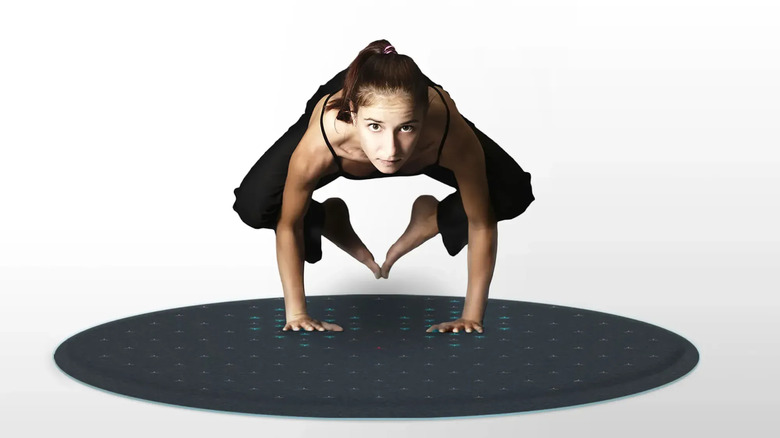What Is A Smart Yoga Mat And How Does It Work?
We may receive a commission on purchases made from links.
Yoga is a great way to improve your overall health. It's good exercise, it makes you more flexible, and it's good for easing stress – yoga even has a long-term impact on clinical depression. But getting into yoga can be a bit of a rough transition. It involves a lot of stretching and movements you might not be accustomed to, and if you're not quite sure what you're doing, there's a chance you could accidentally hurt yourself.
The best way to ensure an ideal yoga experience is to take a class with a professional instructor, but if that's off the table, there are ways to bring a solo yoga session in line with one offered in a class. You could keep a visual list of pose diagrams handy, open up a yoga video on your computer or a yoga app on your phone, or, perhaps, employ a smarter mat.
As smart tech proliferates through anything and everything, even the peaceful realm of yoga has seen technological upgrades in the form of smart yoga mats. While these flexible devices won't magically make you perfectly pretzel-like, their combination of intelligent sensors might just make your yoga journey a teensy bit easier.
A smart yoga mat guides and tracks your progress through yoga programs
A smart yoga mat is kind of like the yoga equivalent of a stationary bicycle or treadmill like the Peloton Tread. Rather than the usual flat strip of foamy material, a smart yoga mat incorporates a variety of subtle sensors, scanners, and even AI algorithms to track your progress through a long-term yoga program. These sensors are used to check your positioning while performing yoga poses, ensuring you're distributing your weight properly, moving the correct limbs, and not overextending yourself in dangerous ways.
Technically speaking, the concept of smart yoga mats have been around since the mid-2010s, with experimental design teams like Fluid and crowdfunded campaigns like Smart Mat researching the possibility of such a product. However, to date, the only smart yoga mat that's managed to make it to commercial availability as far as we can discern is YogiFi, which launched in 2021. No matter what the others promised, YogiFi's the only one to release a product, so it gets to be the benchmark for smart mats going forward.
YogiFi uses various kinds of sensors for tracking movement and pressure
The YogiFi smart yoga mat has a large main device attached to a seemingly normal yoga mat. You power the device on, pair it with a compatible device via the YogiFi app, and select one of the app's programs or classes. An instructional video will play on your connected device, which you're supposed to follow along with on the mat. You can play this lesson on most Bluetooth-compatible displays, including smartphones, tablets, smartwatches, and smart TVs.
The big difference between this and a normal yoga instructional tape is that the YogiFi mat is actively monitoring you as you go. The mat's sensors keep track of your weight and balance, monitoring your poses for safety and accuracy. If the mat detects a problem, such as incorrect balance shifting or performing the wrong pose, the paired device will send you an audio and visual warning to fix your positioning. YogiFi also uses an AI-powered virtual yoga trainer to guide you through the steps of your program, offering advice on improving your poses and generally encouraging you to keep going. This is in addition to the prerecorded professional trainer who's conducting the lesson videos.

